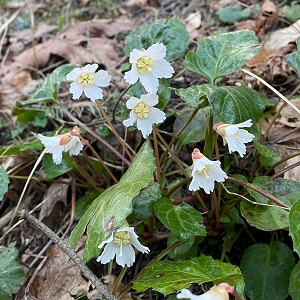I saw this unusual flower in a Portland park. What is it?
This is Shortia galacifolia, also called Oconee Bells, a spring-blooming low-growing evergreen perennial native to Georgia, the Carolinas, and parts of Tennessee and Virginia (in southeastern woodlands within the boundaries of Cherokee lands). It is rare in the wild. It was first ‘discovered’ by plant explorer André Michaux in 1788 (with help from Cherokee guides) and not ‘found’ again for almost a century (by Asa Gray). It was known to the Cherokee long before Michaux and Gray became fascinated by it. Its Cherokee name is ‘shee-show,’ two-colored plant of the gods. Because it grows near the water’s edge, it is said to be a harbinger of spring rain. The common name Oconee is derived from Cherokee, Ae-quo-nee, meaning ‘land beside water.’
You can learn more about it from garden writer Charles Elliott’s two-part essay, The Long Trail of Shortia, linked here and here. There is also an essay about its discovery and rediscovery on the Harvard University Herbaria & Libraries website. It is clear from Michaux’s own documentation that Indigenous people knew a great deal about this plant (“I came back to the camp with my guide at the head of the Keowee and gathered a large quantity of the low woody plants with the saw-toothed leaves that I found the day I arrived. I did not see it on any other mountain. The Indians of the place told me that the leaves had a good taste when chewed and the odor was agreeable when they were crushed, which I found to be the case”), but Michaux and Gray, like so many non-Indigenous plant explorers, did not question the decidedly Eurocentric bias behind the idea of plant discovery and classification.
